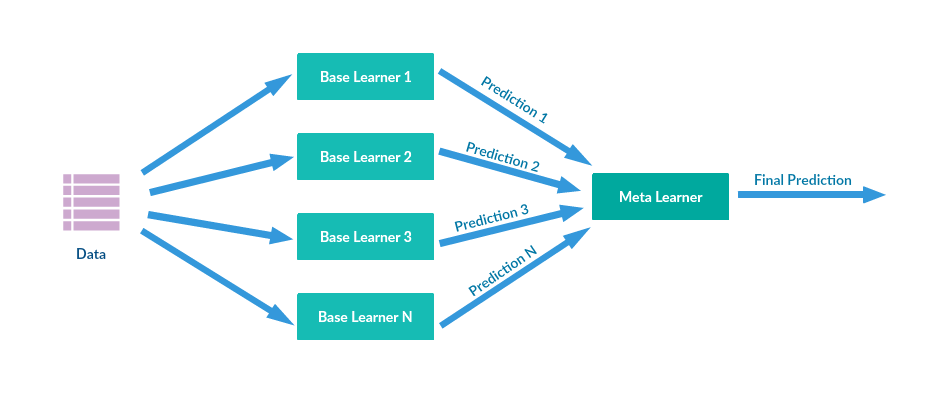
Machine Learning Model Stacking in Python
Last Updated on January 21, 2022 by Editorial Team
Author(s): Suyash Maheshwari
Originally published on Towards AI the World’s Leading AI and Technology News and Media Company. If you are building an AI-related product or service, we invite you to consider becoming an AI sponsor. At Towards AI, we help scale AI and technology startups. Let us help you unleash your technology to the masses.
Machine Learning
Find out how stacking can be used to improve model performance
Stacking is a type of ensemble learning wherein multiple layers of models are used for final predictions. More specifically, we predict train set (in CV-like fashion) and test set using some 1st level models, and then use these predictions as features for 2nd level model.
We can do it in python using a library called ‘Vecstack’. The library has been developed by Igor Ivanov and was released in the year 2016. In this article, we will have a look at the basic implementation of this library for a classification problem.

The library can be installed using :
pip install vecstack
Next, we import it :
from vecstack import stacking
First, we will create individual models and perform hyperparameter tuning to find out the best parameters for all of the models. In order to avoid overfitting, we apply cross-validation split the data into 5 folds, and compute the mean of roc_auc score.
- Decision Tree Classifier :
#Hyperparameter tuning for decision tree classifier
clf = DecisionTreeClassifier()
parameters={'min_samples_split' : np.arange(10,100,10),'max_depth': np.arange(1,20,2)}
clf_random = RandomizedSearchCV(clf,parameters,n_iter=15 , scoring = 'roc_auc' , cv =5 , verbose = True)
clf_random.fit(x_train, y_train)
#Best parameters
{'min_samples_split': 70, 'max_depth': 9}
#mean roc_auc score
0.8142247920534071
Similarly,
2. Random Forest Classifier :
#Best parameters
{'min_samples_split': 90, 'max_depth': 9}
#mean roc_auc score
0.8051500705643935
3. Multilayer Perceptron Classifier :
#Best parameters
{'max_iter': 100, 'learning_rate': 'constant', 'hidden_layer_sizes': (20, 7, 3), 'activation': 'tanh'}
#mean roc_auc score
0.8017714839042659
4. KNeighbours Classifier :
#Best parameters
{'weights': 'distance', 'n_neighbors': 7}
#mean roc_auc score
0.7013120709379057
5. Support Vector Machine Classifier :
#Best parameters
{'max_iter': 700}
#mean roc_auc score
0.8672302452275072
Next, we create a base layer for our stacking model bypassing all of the above-mentioned models. We want to predict train set and test set with some 1st level models, and then use these predictions as features for 2nd level models. Any model can be used as a 1st level model or a 2nd level model.
# 1st level models
models = [KNeighborsClassifier(n_neighbors= 3) ,
DecisionTreeClassifier(min_samples_split= 70,max_depth=9),
RandomForestClassifier(min_samples_split= 90,max_depth=9),
MLPClassifier(max_iter= 100, learning_rate='constant',hidden_layer_sizes= (20, 7, 3), activation= 'tanh') ,
LinearSVC(max_iter= 700) ]
S_Train, S_Test = stacking(models,
x_train, y_train ,x_test ,
regression=False,
mode='oof_pred_bag',
needs_proba=False,
save_dir=None,
metric= roc_auc_score,
n_folds=4,
stratified=True,
shuffle=True,
random_state=0,
verbose=2)
Next, we pass the predictions of these models as input to our layer 2 models which is the MLP classifier in this case. We also perform Hyperparameter Tuning and Cross-Validation for this model.
mlp = MLPClassifier()
parameters = {'hidden_layer_sizes':[(10,5,3), (20,7,3)], 'activation':['tanh', 'relu'], 'learning_rate':['constant', 'adaptive'], 'max_iter' :[100, 150]}
mlp_random = RandomizedSearchCV(mlp,parameters,n_iter=15 , scoring = 'roc_auc' , cv =5 , verbose = True)
mlp_random.fit(S_Train , y_train)
grid_parm=mlp_random.best_params_
print(grid_parm)
print(mlp_random.best_score_)
The mean of the Roc_Auc score for the final model is 0.9321746030659209.
Conclusion :
Therefore, using stacking we were able to improve the performance of the model by at least 7%! Stacking is a way to combine the strengths of multiple models into a single powerful model. Having said this, Stacking may not always be the best thing to do as it involves significant use of computational resources and the decision to use it must be decided based on the business case, time and money. A huge shoutout to Igor Ivanov, developer of this library, for such amazing work.
Machine Learning Model Stacking in Python was originally published in Towards AI on Medium, where people are continuing the conversation by highlighting and responding to this story.
Join thousands of data leaders on the AI newsletter. It’s free, we don’t spam, and we never share your email address. Keep up to date with the latest work in AI. From research to projects and ideas. If you are building an AI startup, an AI-related product, or a service, we invite you to consider becoming a sponsor.
Published via Towards AI
Take our 90+ lesson From Beginner to Advanced LLM Developer Certification: From choosing a project to deploying a working product this is the most comprehensive and practical LLM course out there!
Towards AI has published Building LLMs for Production—our 470+ page guide to mastering LLMs with practical projects and expert insights!

Discover Your Dream AI Career at Towards AI Jobs
Towards AI has built a jobs board tailored specifically to Machine Learning and Data Science Jobs and Skills. Our software searches for live AI jobs each hour, labels and categorises them and makes them easily searchable. Explore over 40,000 live jobs today with Towards AI Jobs!
Note: Content contains the views of the contributing authors and not Towards AI.














